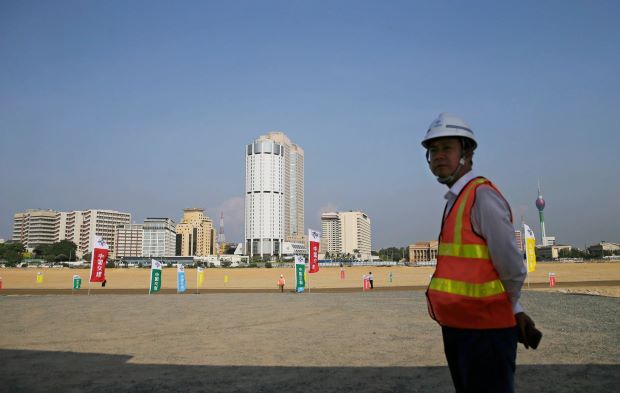China-backed ‘white elephant’ projects in Sri Lanka dent investor confidence amid calls for policy revamp
By Dimuthu Attanayake
COLOMBO – For years, several China-linked projects in Sri Lanka have come under fire for being “white elephants” that have failed to contribute significantly to its economy, but a free-trade agreement between both countries, policy revamp and more involvement by joint ventures could turn the tide, analysts say.
Among the underperforming projects are the Mattala Rajapaksa International Airport (MRIA), built with US$ 191 million financing from the Exim Bank of China; Hambantota International Port (HIP) built by China Harbour Engineering Company (CHEC) with US$ 1.3 billion of credit from China; and the Port City Colombo (PCC), a US$ 1.4 billion project also built by CHEC.
All three projects are part of the Belt and Road Initiative, a China-led initiative aimed at improving trade and economic integration across Asia, Europe and Africa.
Recent initiatives have been unveiled to turn things around for the mega projects.
Former British prime minister David Cameron flew to the Middle East in September to speak at two events in a bid to lure investments in the PCC. Agreements to set up a commercial dispute resolution centre and introduce tax holidays for investors in the port have also been signed in the past year.
The Sri Lankan government announced earlier this month a plan to award an oil refinery project near HIP to China-owned Sinopec, as part of efforts to boost shipments of oil products through the port.
Kasun Thilina Kariyawasam, a Sweden-based economist, said more needs to be done to boost the confidence of investors and businesses in these projects, especially for those from China.
“[Sri Lanka] should go for an all-weather cooperation agreement with China to ensure that regardless of its political instabilities, there will be support for Chinese investments,” he told This Week in Asia.
Such an agreement would assure investors that policies would remain in place even with a change of government.
Years of economic mismanagement have led to Sri Lanka facing its worst economic crisis since independence in 1948 and sovereign debt defaults. In July last year, then-president Gotabaya Rajapaksa fled the country and resigned following deadly public protests.
During Sri Lankan President Ranil Wickremesinghe’s visit to China last month, President Xi Jinping said efforts must be made to promote PCC and HIP.
A free-trade deal between China and Sri Lanka would be crucial to enhance investments in the two ports and other mega projects, Kariyawasam said. As such, Colombo should prioritise and push for the signing of the agreement, he added.
Some economists have blamed high-interest Chinese loans linked to Beijing-backed projects for causing Sri Lanka to face a “Chinese debt trap” amid its economic crisis last year.
China was Sri Lanka’s largest lender, holding almost 20% of the country’s public external debt as of the end of 2021.
It remains key to the ongoing Sri Lankan debt-restructuring negotiations led by the International Monetary Fund (IMF). In October, Sri Lanka reached an agreement with the Exim Bank of China to cover about US$ 4.2 billion of its debt, a crucial step in the country’s ongoing IMF programme.
Given its sizeable debt, Sri Lanka should tap equity funding rather than borrow further as a lifeline for its mega projects, said an economist familiar with Sri Lanka’s debt restructuring and who declined to be named.
“The focus should be on getting equity flows. If loans are needed, it should be loans given directly to the private sector in a public-private partnership,” the source said.
Another strategy that Sri Lanka could adopt is to leverage joint ventures to drive mega projects, according to analysts.
One such example is the HIP, which has been showing signs of progress in the past year. The port managed by the Chinese-Sri Lankan joint venture, the Hambantota International Port Group (HIPG), handled 80% of bunkers in the Sri Lankan market in the first eight months of this year, a five-time surge compared with last year’s total. It also reported an increase in the transhipment of vehicles in recent months.
The HIPG is a good example of joint ventures working better than the government overseeing this type of mega projects, says Umesh Moramudali, an economics lecturer from the University of Colombo.
Moramudali noted that port operator China Merchants Port (CMPort) had been trying to entice other Chinese investors to be involved in projects in Sri Lanka. “There’s potential there and I think that it [Chinese JV investment] will expand with time,” said Moramudali, who is also a co-author of a paper on Chinese lending to Sri Lanka.
While CMPort-led businesses in Sri Lanka may not be very profitable right now, their involvement could still ease short-term financial pressure faced by the local port authorities, Moramudali added.
The joint-venture model could also boost the fortunes of MRIA, according to Moramudali. Once dubbed as “the world’s loneliest airport”, MRIA handled only 216 international aircraft and 11,577 passengers last year.
One key challenge for potential investors in Sri Lanka has been the lack of coordination and harmonization of policies for mega projects.
An example is HIP where investors are seeking clarity on the policies related to the port’s industrial focus, Kariyawasam said. There is a need to clearly highlight the investment incentives for HIP as this would in turn facilitate bank lending to businesses there and boost the port’s utilisation rate.
While the PCC has drawn criticisms from the IMF for its special economic zone (SEZ) with tax holidays, such financial incentives to lure investors are necessary to compete with SEZs in Dubai and India, Kariyawasam said.
Given Sri Lanka’s focus on growing its industries, PCC can become a base to support industrialisation and implement pioneering policies, he added.
-Dimuthu Attanayake is an independent journalist and a researcher from Sri Lanka, covering business, tech, social issues, and the environment and this article was originally featured on scmp.com



Comments are closed, but trackbacks and pingbacks are open.